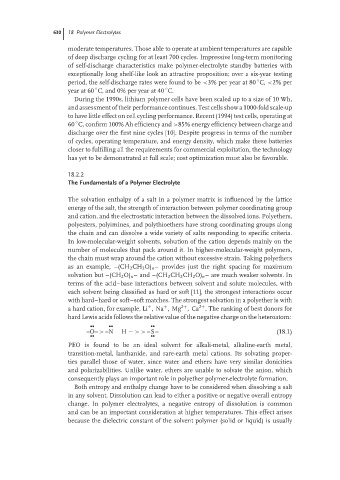Page 656 - Handbook of Battery Materials
P. 656
630 18 Polymer Electrolytes
moderate temperatures. Those able to operate at ambient temperatures are capable
of deep discharge cycling for at least 700 cycles. Impressive long-term monitoring
of self-discharge characteristics make polymer-electrolyte standby batteries with
exceptionally long shelf-like look an attractive proposition; over a six-year testing
◦
period, the self-discharge rates were found to be <3% per year at 80 C, <2% per
◦
◦
year at 60 C, and 0% per year at 40 C.
During the 1990s, lithium polymer cells have been scaled up to a size of 10 Wh,
and assessment of their performance continues. Test cells show a 1000-fold scale-up
to have little effect on cell cycling performance. Recent (1994) test cells, operating at
◦
60 C, confirm 100% Ah efficiency and >85% energy efficiency between charge and
discharge over the first nine cycles [10]. Despite progress in terms of the number
of cycles, operating temperature, and energy density, which make these batteries
closer to fulfilling all the requirements for commercial exploitation, the technology
has yet to be demonstrated at full scale; cost optimization must also be favorable.
18.2.2
The Fundamentals of a Polymer Electrolyte
The solvation enthalpy of a salt in a polymer matrix is influenced by the lattice
energy of the salt, the strength of interaction between polymer coordinating group
and cation, and the electrostatic interaction between the dissolved ions. Polyethers,
polyesters, polyimines, and polythioethers have strong coordinating groups along
the chain and can dissolve a wide variety of salts responding to specific criteria.
In low-molecular-weight solvents, solvation of the cation depends mainly on the
number of molecules that pack around it. In higher-molecular-weight polymers,
the chain must wrap around the cation without excessive strain. Taking polyethers
as an example, –(CH 2 CH 2 O) n – provides just the right spacing for maximum
solvation but –(CH 2 O) n – and –(CH 2 CH 2 CH 2 O) n – are much weaker solvents. In
terms of the acid–base interactions between solvent and solute molecules, with
each solvent being classified as hard or soft [11], the strongest interactions occur
with hard–hard or soft–soft matches. The strongest solvation in a polyether is with
2+
2+
+
+
a hard cation, for example, Li ,Na ,Mg ,Ca . The ranking of best donors for
hard Lewis acids follows the relative value of the negative charge on the heteroatom:
•• •• ••
–O– > –N H − >> –S– (18.1)
•• ••
PEO is found to be an ideal solvent for alkali-metal, alkaline-earth metal,
transition-metal, lanthanide, and rare-earth metal cations. Its solvating proper-
ties parallel those of water, since water and ethers have very similar donicities
and polarizabilities. Unlike water, ethers are unable to solvate the anion, which
consequently plays an important role in polyether polymer-electrolyte formation.
Both entropy and enthalpy change have to be considered when dissolving a salt
in any solvent. Dissolution can lead to either a positive or negative overall entropy
change. In polymer electrolytes, a negative entropy of dissolution is common
and can be an important consideration at higher temperatures. This effect arises
because the dielectric constant of the solvent polymer (solid or liquid) is usually

